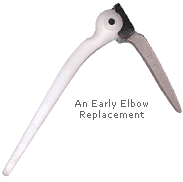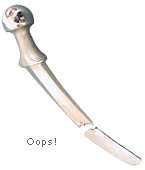Reducing Wear
Misunderstanding Motion
Many early replacement joints tended to fail because they did not reproduce the true motion of the joint. Their unnatural motion created unusual stresses on the surrounding parts of the patient's body, tended to loosen the bond that held the joint in place, or caused the implant itself to wear quickly or break.
This design for an elbow replacement is based on a simple hinge, although the true motion of the elbow is quite complex and includes the ability to rotate the forearm.
Imagine trying to perform common motions, such as picking up and drinking from a cup or doing up shirt buttons, without being able to rotate your forearm!
A patient who received this implant and tried to move in his or her usual fashion would subject the "hinge" to ongoing stress.
This hip replacement in the museum's collection broke while implanted in a patient and had to be replaced.
This is a modern implant and the cause of the break is not known, but it dramatically illustrates the strength of the forces that can be exerted on an implant while in use.
That's why it's so vital to understand the motion of each joint and the forces to which it is subject.




